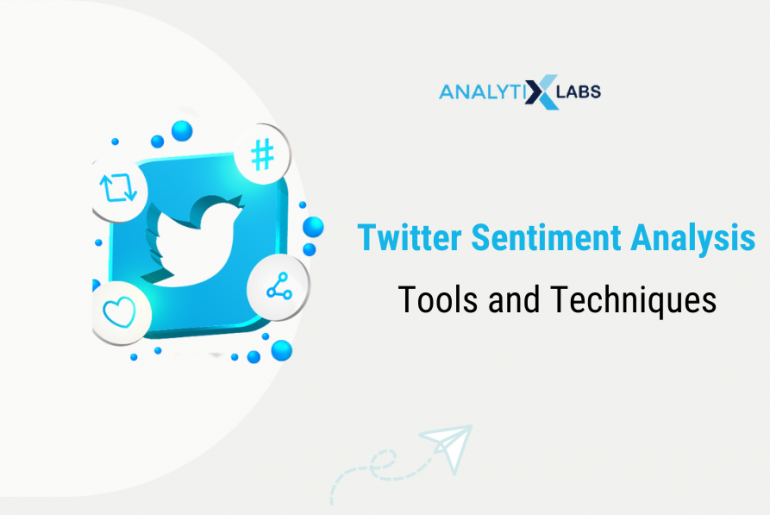The advancements of AI and ML in day-to-day life, both on personal and professional fronts, are powerfully exceptional. Today almost everything on the internet is traceable, even your sentiments and emotions.
Amidst fast-paced digitalization, social language has established its remarkable presence globally. Social media posts, blogs, online forums, product review portals, and many others are the new-age modes of expressing opinions. These all contribute to the billions of User Generated Content (UGC) driving real businesses in the current scenario.
Following the Statista Reports, Facebook records approximately 19.7 billion visits/month, Twitter 7.1 billion, and Instagram 6.5 billion. Undoubtedly, these platforms provide enormous data to work on. Being one of the most used platforms, Twitter data sentiment analysis becomes crucial for business analytics.
Sentiment Analysis is a prominent AI-powered technology. It effectively monitors emotions, sentiments, opinions, appraisals, and attitudes in the UGC. In this article, we will study the science behind it by understanding Twitter Sentiment Analysis.
We will also look at the necessity for Twitter Sentiment Analysis, discover popular tools for Twitter data sentiment analysis, and the process of conducting Tweet sentiment analysis.
What is Twitter Sentiment Analysis?
Twitter sentiment analysis is a real-time automated machine-learning technique that determines and categorizes the subjective context in tweets .
Sentiment analysis of Twitter data involves Opinion Mining to analyze the psychological intent in a tweet – positive, negative, or neutral. Then, based on the patterns identified during text mining, it predicts the subsequent thread of texts.
This does not guarantee 100% prediction accuracy on emotions expressed but has the power to enable and enriches brands’ interaction with customers.
With an average of around 10,033 tweets per second, as reported in May 2022, the growing number of tweets per day is generating a vast amount of data.
Reasonably analyzing the tweets on a manual or community basis is tedious. Moreover, it is much harder for brands to prioritize their response corresponding to each tweet, retweet, mention, and comment.
Twitter Sentiment Analysis machine learning uses Natural Language Processing (NLP) classification algorithms to cope with the challenge. Wherein Logistic Regression, Bernoulli Naive Bayes, and Support Vector Machine (SVM) are well-known classifiers.
Overall, it plays a pivotal role in establishing brands’ presence on Twitter. They get to understand their –
- Target audience’s perspective in-depth
- Competitors’ emotional marketing campaigns and responses
- Industry’s new trends for impactful brand positioning
Why Twitter Sentiment Analysis?
The top four reasons why sentimental analysis of Twitter data is of utmost importance –
1. Real-time 24X7 Supervision
It includes the entire brand monitoring to maintain the online reputation. From analyzing customer feedback to monitoring every Twitter mention about the brand, its products, new launches, and ongoing campaigns.
Concurrent Twitter data mining helps brands in the end-to-end SWOT analysis. The data-driven insights lead to better decision-making, and quick improvements following customers’ concerns build loyalty.
For example, read how Brandwatch and Co-op used Twitter data to monitor brand activity across various time frames.
2. Ensure Customer Success
Research shows that the average wait time on Twitter to hear back from a brand is somewhere between one day and 7 hours. However, most customers want to hear within an hour, and brands are continuously striving to do that.
It is the primitive goal of brands and a major reason for deploying Twitter Sensitive Analysis. This innovative technique efficiently tracks high-priority critical issues that require an immediate response.
For instance, this tweet to Google Pay, one of the largest UPI payment portals. This tweet clearly shows what is annoying customers, indicating for quick action to resolve it at the earliest.
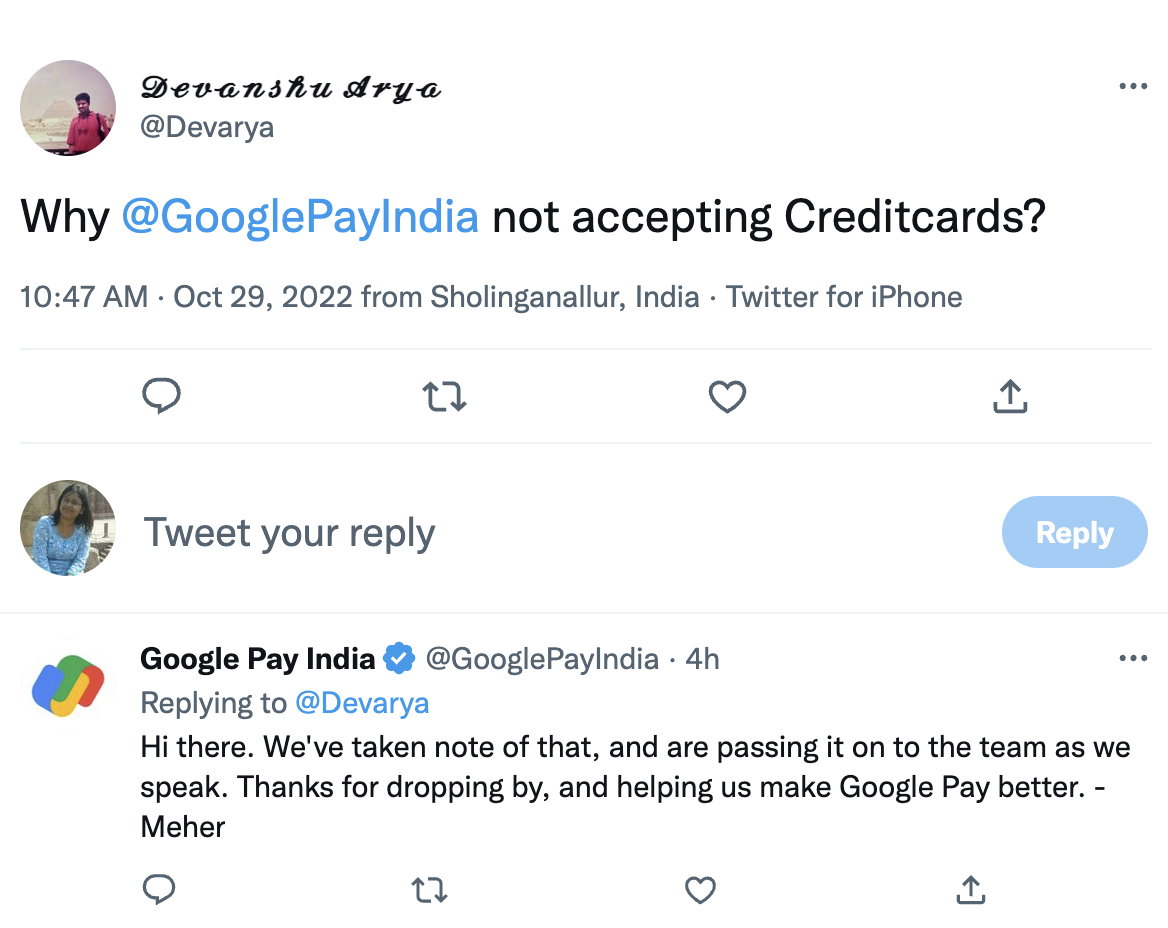
We cannot deny that Twitter has become the customers’ favorite platform to express appreciation and resentment. Due to this, brands need to be ultra-proactive in addressing their customers’ queries, positive reviews, or frustration.
It is not just the role of the primary brand social handle. Even employees of a brand can be the voice occasionally, bridging the gap between brands and customers in real-time (and with a personal touch).
For instance, here’s a look at a conversation between Bubble’s developer and a user, which also gives an insight into what users are expecting from the brand. In turn, the developer assures of the upcoming roadmap – consequently strengthening the brand-to-customer relationship.

This may not be a classic customer service/success conversation but monitoring these tweets can help a brand gauge how happy its customers are, what they are looking for, and how far along the brand is in customer satisfaction.
3. Market Study
The Twitter Sentiment Analysis dataset is a key instrument for determining customers’ pain points and notable discernments. It tracks and analyzes keywords to compute the customers’ perceptions.
The users on Twitter freely express their thoughts and convictions on a multitude of topics. It eventually helps brands identify the customers’ persona, behavior, likes, and dislikes based on interests and trends.
For instance, this tweet clearly shows the impact Amazon Prime’s pricing has on the Indian audience currently. Such tweets enable brands to foray in the right direction with their product and pricing strategy.

Aspect-based sentiment analysis on Twitter (and any other social platforms) can help brands understand with clarity what customers want, and accordingly decide what to improve.
4. Political Campaigns and Public Actions
The package used for Twitter Analysis captures the track record of news and debates on political views. In the current scenario, monitoring inconsistencies to detect potential issues is imperative.
Twitter sentiment analysis can very well help gauge election results way before the elections have happened. Infact, research shows how strongly Twitter sentiment analysis paved way for Donald Trump’s win in the 2016 US Presidency.
For example, MonkeyLearn used Twitter sentiment analysis during the 2016 US presidential elections and compared the polarity of tweets related to Trump and Clinton. The analysis showed positive, negative, and neutral sentiments across days until the day of the election. The two graphs clearly show what led to Trump’s final win.
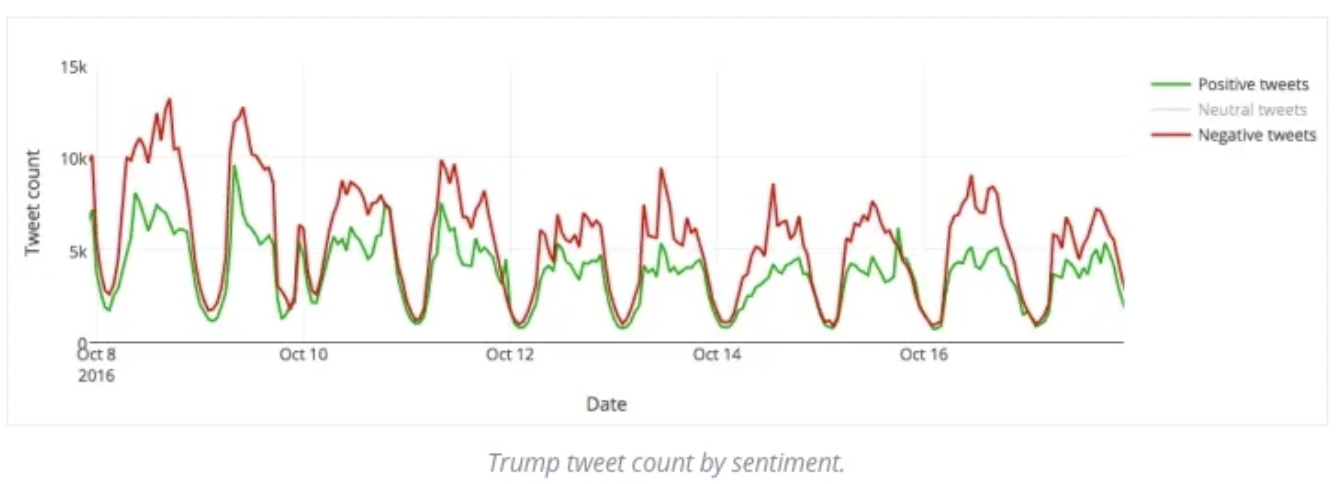
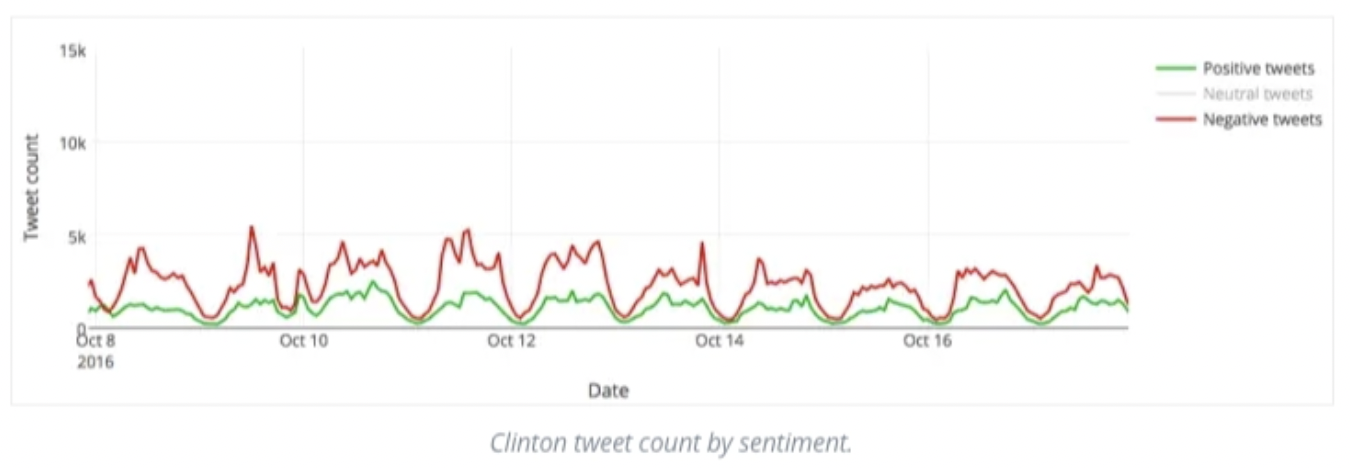
Twitter is an excellent place to have the exact blueprint of public opinion. However, these campaigns could be outrageous; therefore, it is necessary to predict public actions to avoid dangerous circumstances.
How to do Twitter Sentiment Analysis?
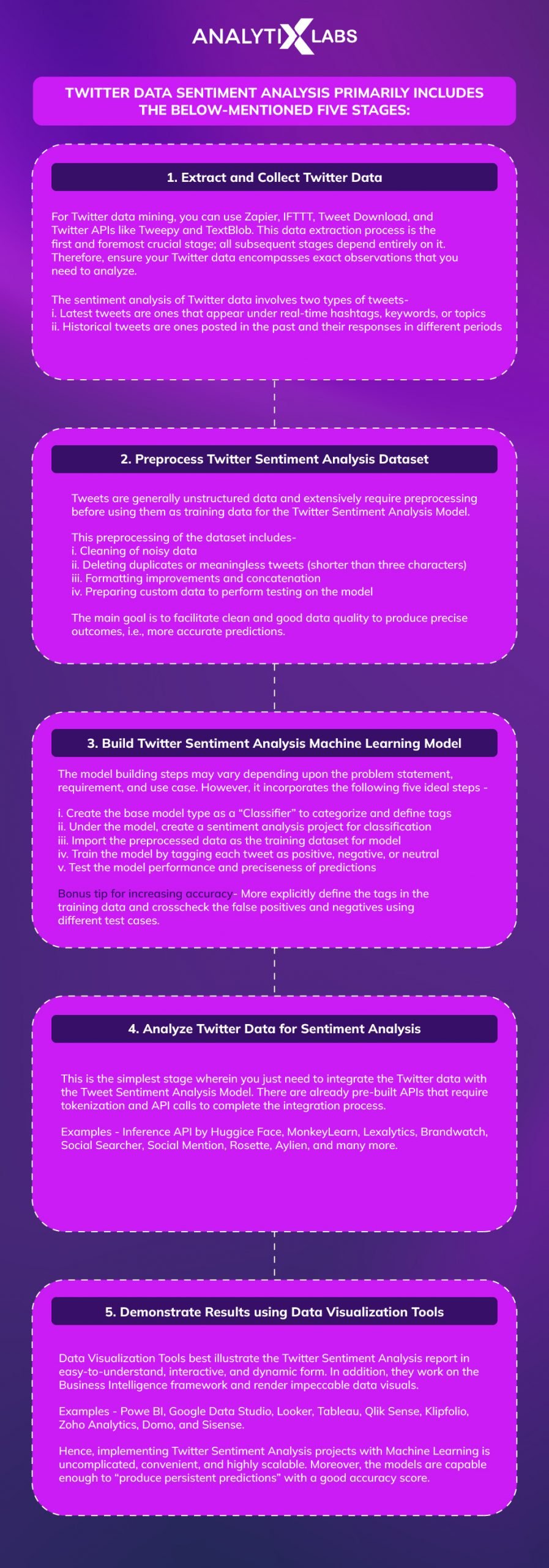
Here’s a visual guide to doing Twitter sentiment analysis using Python .
Twitter Sentiment Analysis in R
R is a popular programming language used for deep statistical analysis. They are mainly used in Twitter data mining. Moreover, you can also build up an app for extracting and visualizing data from Twitter.
Using RStudio, users can instantly connect to and extract data that is made available to the general public. RStudio has been a great plus point since it has great plotting tools along with a brilliant visual interface. Here’s a quick guide to starting with R and RStudio by How to R.
In addition to Python, R helps in Twitter sentiment analysis through its built-in packages. R offers more flexibility and customization than any other analysis tool.
Twitter Sentiment Analysis with Python
Python offers an easy-to-use library known as Tweepy for accessing the Twitter API. Using a few sample codes through a Twitter developer account you can initiate the analysis.
- Use the following commands to install the required Python libraries:

- Next, import all other libraries required for sentiment analysis.

- Authenticate the Twitter API in the next step.

- Provide the required parameters for sentiment analysis.
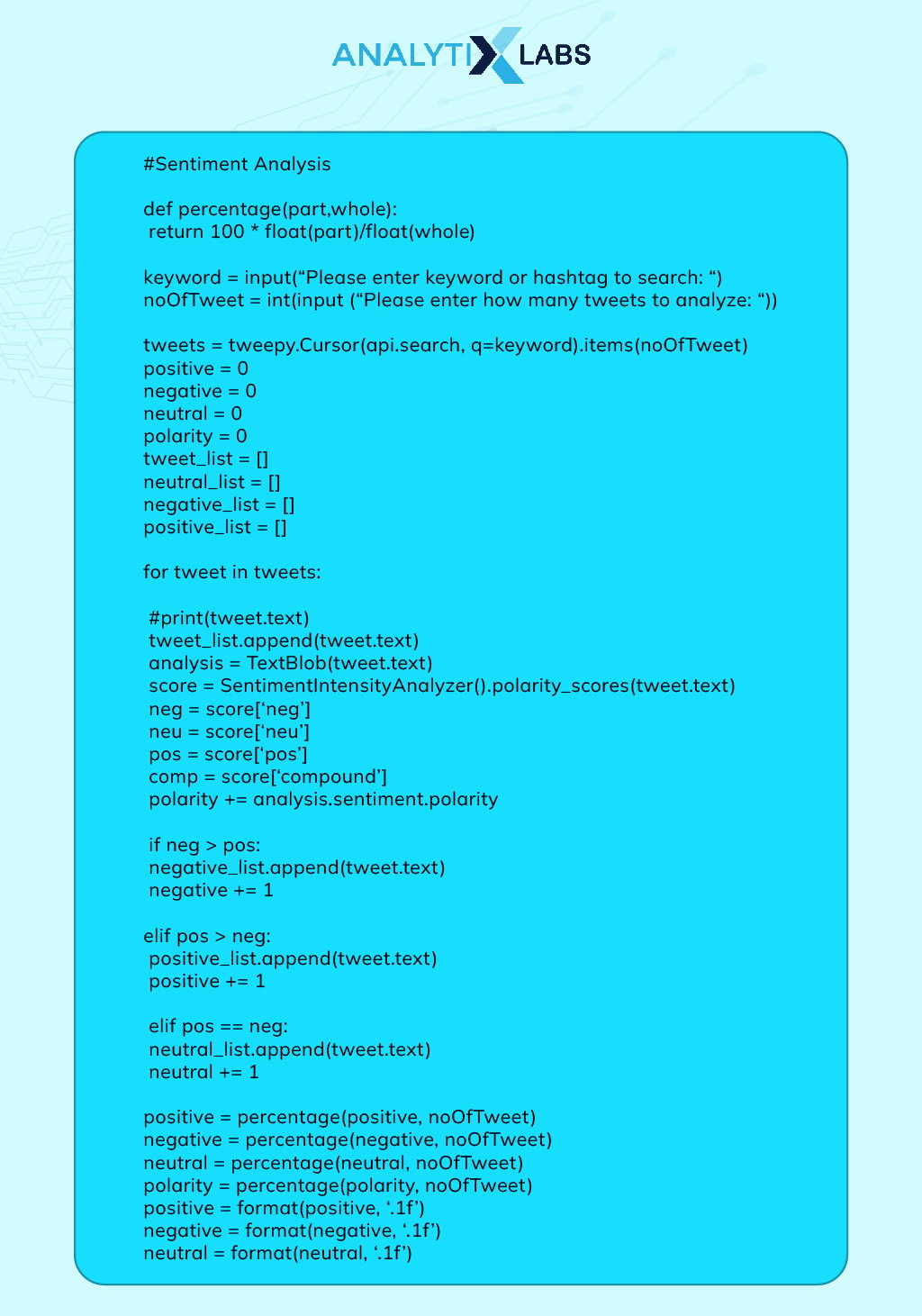
- Categorize the Twitter sentiment analysis dataset based on the sentiment tags .
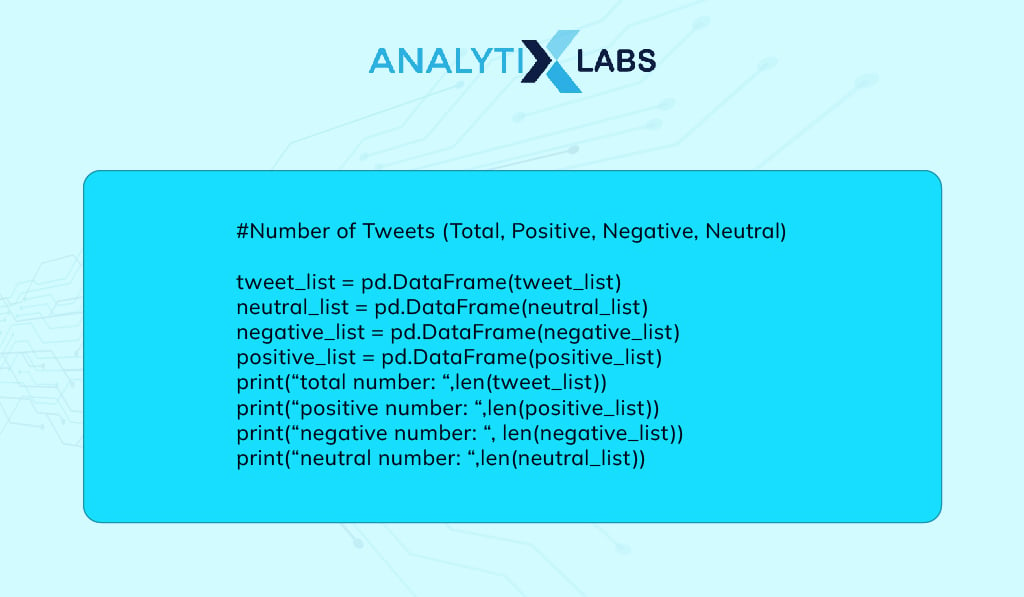
- The results can then be visually presented through a pie chart for a fairer insight.

Data Cleansing for accurate results
- Cleaning data is necessary to improve the accuracy of the results so we will remove any duplicates using the following code:
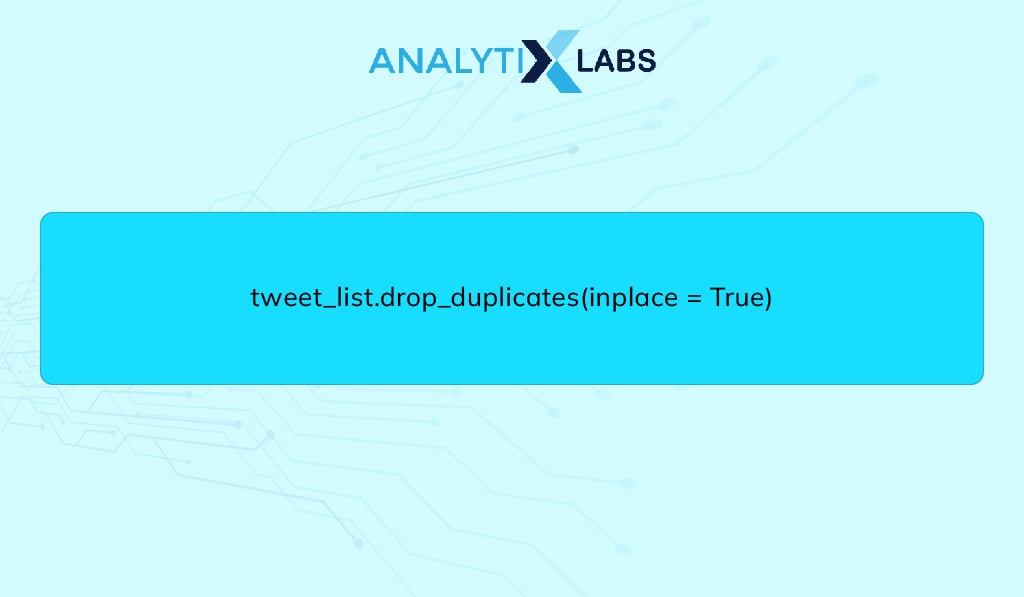
- The data must also be cleansed of any punctuations, retweets, and links . It can be done using the lambda function and then converted to lowercase.
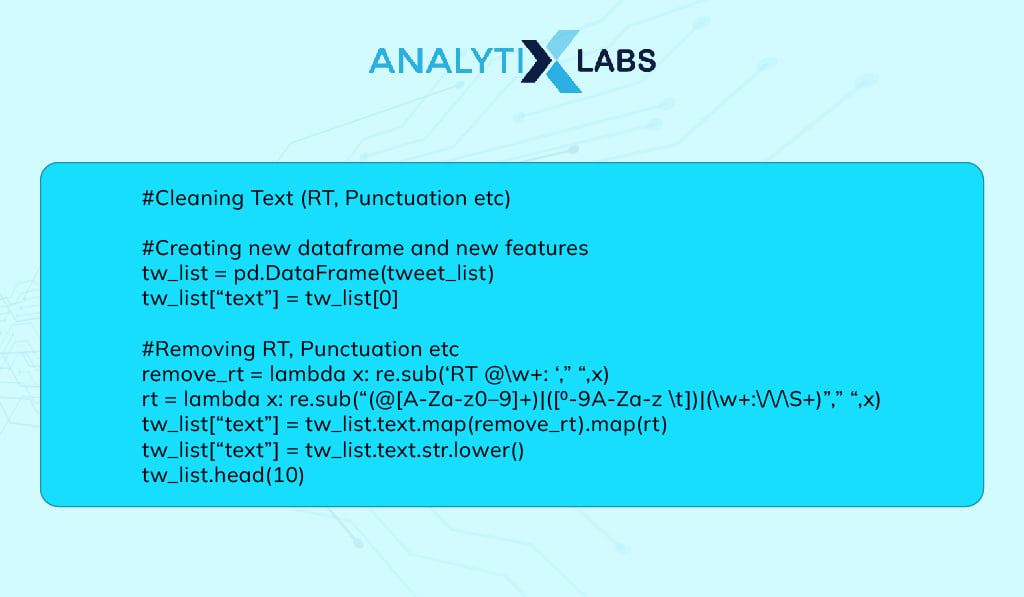
- Now the cleansed data can be analyzed for the defined sentiment parameters.
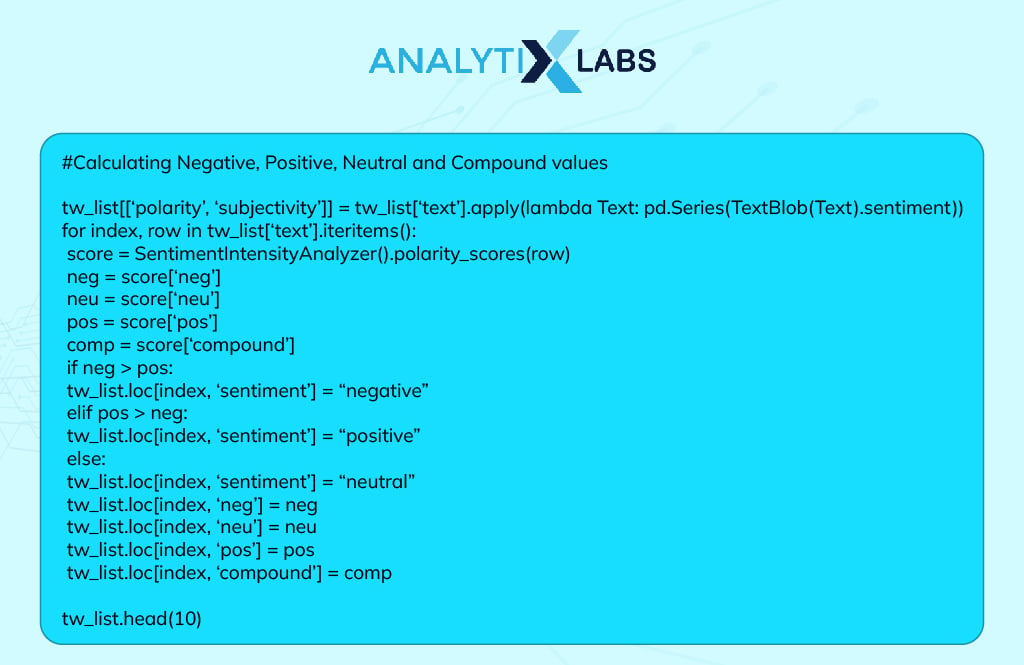
- The result is then classified into the three sentiment groups – positive, negative, and neutral.
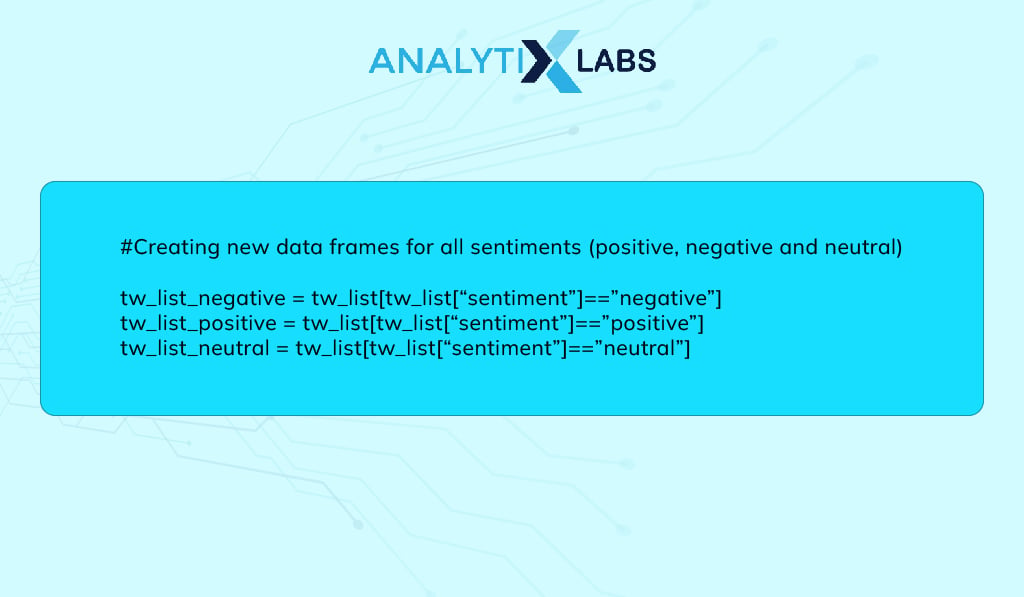
- Next, calculate the percentage of each sentiment to get an insight.
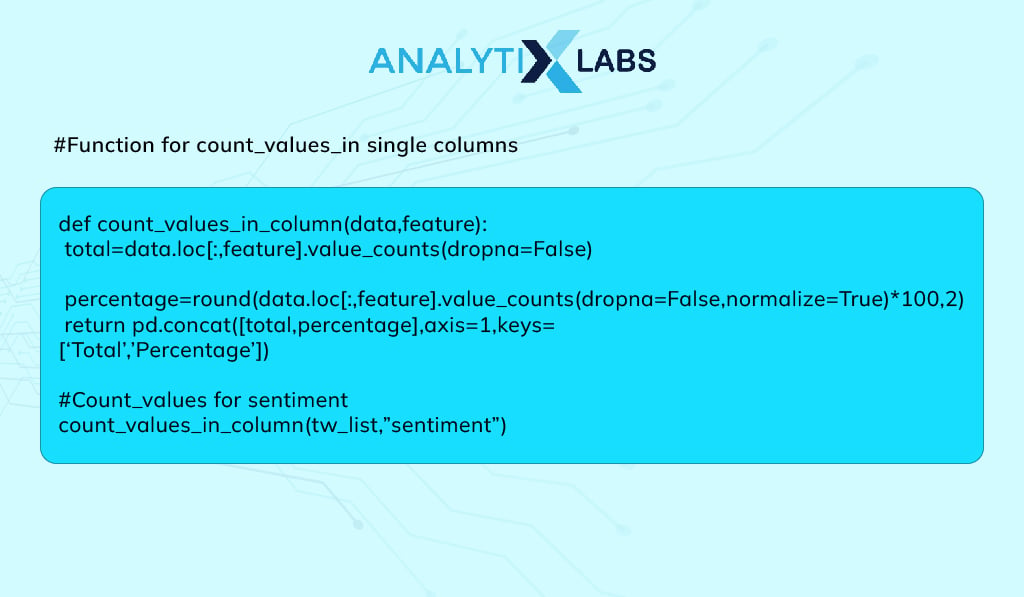
- It can be further represented as a pie chart for better visualization.
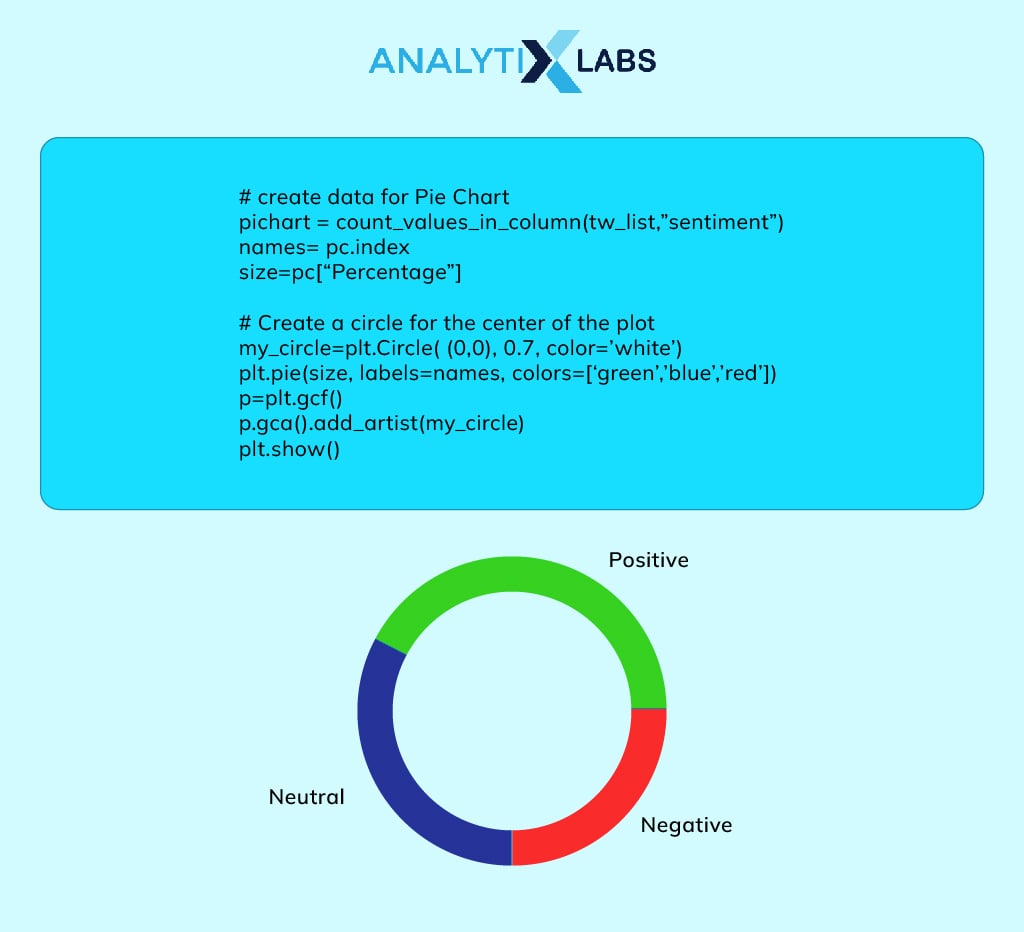
Tools for Twitter Sentiment Analysis
There are certain tools available for undergoing a Twitter sentiment analysis. These tools monitor and scrutinize the tweets, their tone, sentiments, and emotions behind them. They unfold the hidden aspects in a message or a tweet so that you will be able to understand the purpose or sentiment. Some of the popular analysis tools are as follows:
-
Enginuity Analytics
Enginuity Analytics is an eminent social media sentiment analysis tool. Its robust search engine helps brands in mining data-rich actionable market insights.
Enginuity Analytics is preferable for measuring the target audience’s emotional response and how exactly they perceive the brand’s content.
Features –
- Monitors content from over 100 million social and web data sources
- Discovers socially pertinent opinions across 27 global languages
- Expert in end-to-end surveillance from the brand itself to its competitors
- Determines uptrends and accordingly predicts outcomes
- Generates Smart Email Reports encompassing majorly –
- Social Relevance Score
- Total Social Shares
- Top Social Network by Shares
- Content and Social Opinion Ratings
- Popular Content and Social Opinions
-
NCSU Tweet Visualizer
NCSU Tweet Visualizer is specifically a Tweet Sentiment Analysis Tool and works supremely for market research on Twitter. The app is free and powered by the NC State University (NCSU) – Department of Computer Science.
NCSU Tweet Visualizer follows Russell’s model of emotional effect for measuring the sentiment corresponding to each search phrase.
Features –
- Simply keyword-based searching and mapping
- Uses sentiment dictionaries like POMS and ANEW
- Showcases each tweet’s details in color, brightness, size, and transparency
- Estimates every tweet based on underlying psychological intent, the emotion expressed, content authority, and audience response
- Visualizes analytics in nine different forms – Sentiment, Topics, Heatmap, Tag Cloud, Timeline, Map, Affinity, Narrative, and Tweets
-
Social Searcher
Social Searcher is the leading real-time social media search and media monitoring tool. It is useful for tracking social mentions, users, trends, and sentiments.
For exclusive sentiment analysis projects, Social Searcher depicts the actual proportion of every social mention. Along with the breakdown of popular posts color-coded by positive, negative, and neutral sentiments.
Features –
- Fetches data across all social channels into a central easy-to-understand interactive dashboard
- Enables instant email alerts and live notifications
- Provides comprehensive analytics with unlimited mentions history and advanced filtering and sorting
- Performs opinion mining for posts in English, Italian, German, Portuguese, French, Russian, Dutch, and Spanish languages
- Avails actionable social analytics – audience insights, popular hashtags, sentiment analysis, and top-performing social influencers
-
Brandwatch
Brandwatch facilitates enterprise-level consumer intelligence and social media management suite. In addition, Brandwatch is best known for understanding the customer’s voice and quickly determining sentiment variations.
Notably, in 2020, the Forrester Wave recognized Brandwatch as the Leading Social Listening Platform for its exceptional sentiment analysis capabilities. Also, it is the Official Partner of Meta, TikTok, and Twitter for business.
Features –
- Produces social insights with high-precision
- Monitors brand’s social mentions across 100 million+ data sources
- Includes a unique feature of image-based insights
- Specializes in tracking brand visibility 24X7 real-time
- Uses six machine learning custom classifiers for the sentiment analysis projects – joy, surprise, anger, disgust, fear, and sadness
-
MeaningCloud
MeaningCloud is the best-in-class multilingual sentiment analysis API, especially for larger sets of textual data. Its core feature is capturing sentiment(s) within each sentence of a particular text.
In addition, MeaningCloud helps execute various text analytics operations like extracting topics, classifying texts, and tagging parts of speech. And undeniably, it is the most appropriate tool for Twitter Sentiment Analysis.
Features –
- Explicitly distinguishes the context in terms of opinions versus facts
- Efficiently detects the irony, polarity, contradictions, and ambiguity
- Supports English, Spanish, Italian, French, and Catalan languages
- Permits to add custom dictionary to generate more accurate results
- Uses aspect-based based sentiment analysis to extract the text’s nature – positive, negative, or neutral
How to do Twitter Sentiment Analysis Without Coding?
Over social media, brands can grow overnight or lose some potential customers just because their reputation is built on reviews or comments about their brand. To refrain from any kind of negative comment influencing the brand’s popularity, AI-driven sentiment analysis is performed.
Twitter sentiment analysis is concerned with the huge data present on Twitter in the form of comments, posts, reviews, etc that can indicate the present market favor of a particular company.
Now, when we talk about artificial intelligence, it’s not all about developing large codes to use a system. You can apply sentiment analysis of Twitter data even without coding in just 3 effective steps.
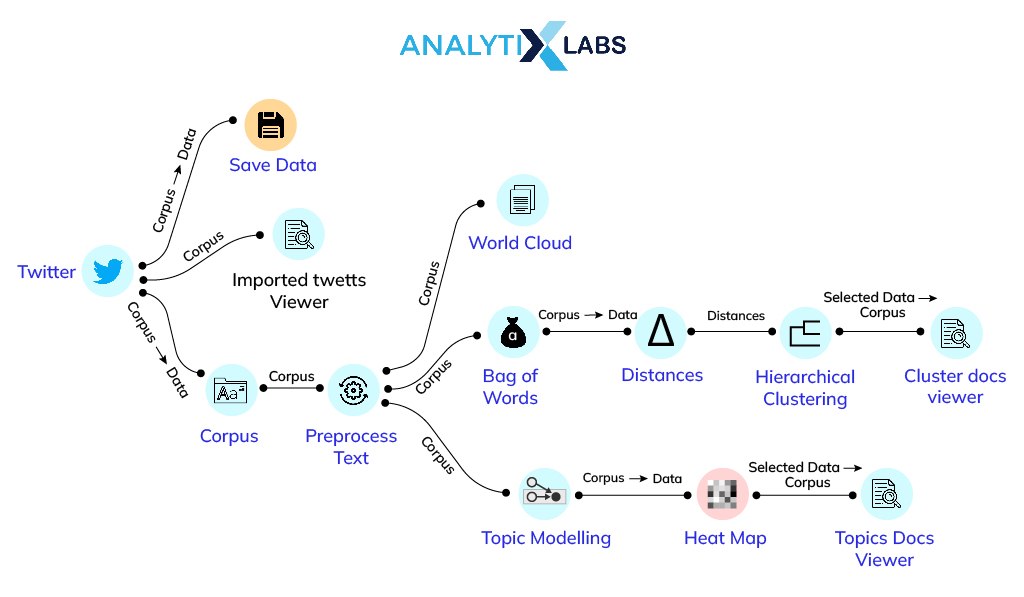
Step 1: Define Sentiment Categories
The primary step is to set all the common sentimental triggers to define the categories in which each tweet can be classified.
For an effective Twitter data sentiment analysis, the right tags are important. To train the AI model, find generic emotional tags like positive, negative, and neutral.
Then, dig deeper to find tags for each of these sentiments like happy, interested, and excited for positive. On the other hand, set disappointed, sad, or angry for negative tags.
Step 2: Find Each Form of Data
The next step is to find suitable data from Twitter data mining. An efficient Tweet sentiment analysis tool can accept different forms of data including texts, PDFs, and images.
You can use Inference API to integrate your ML model to predict the sentiment. You need to at least have two different labels and 20 data points initially, to train the model. Based on your requirement, you can always manipulate the classifications to get desired Twitter sentiment analysis.
Step 3: Explore the Results
Finally, you need to explore the obtained results from the AI model that uses NLP (Natural Language Processing) to predict the sentiment of a single tweet or a whole dataset of them.
For example, if there is a particular tweet about a restaurant saying, I love their food, the sentiment analysis project would detect the word ‘love’ and categorize it as positive feedback.
Similarly, all these results need to be stored in a Google sheet, separated by dates. And then, you can create a graph to get a visual trend of the Tweet sentiment analysis.
Frequently Asked Questions
1. Which Algorithm is used in Twitter Sentiment Analysis?
There are multiple types of algorithms available that can be applied to the sentiment analysis of Twitter data. Some of the most efficient algorithms are Support Vector Machine (SVM), Recurrent Neural Network (RNN), Convolutional Neural Network (CNN), Random Forest, Naïve Bayes, and Long Short-Term Memory (LSTM).
2. How do you do Sentiment Analysis in Python Twitter?
Twitter sentiment analysis machine learning in Python is done via three major steps. Firstly, the Twitter API client is authorized, and then by making a GET request to the Twitter API (Tweepy), you can fetch the potential tweets. Finally, all the data points (tweets in this case) are parsed to categorize them as positive, negative, or neutral.
3. How do I use Naive Bayes for Twitter Sentiment Analysis?
According to the Naive Bayes algorithm, the Twitter sentiment analysis dataset is classified based on the probabilities of the particular classes assigned to texts. It is done by using the joint probabilities of words and classes in the analysis. However, this algorithm considers that each word is independent of the others.
4. How do you do a Sentiment Analysis?
As the name suggests, sentiment analysis is a natural language processing approach under deep learning where any text or image can indicate the emotion behind it. For example, sentiment analysis of Twitter data is done by training a large dataset about the positive, negative, and neutral words that are commonly used. Then, with the sentiment analysis approach, these keywords can predict the complete emotion of a sentence.

